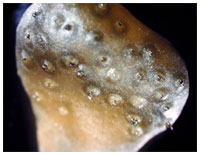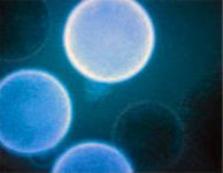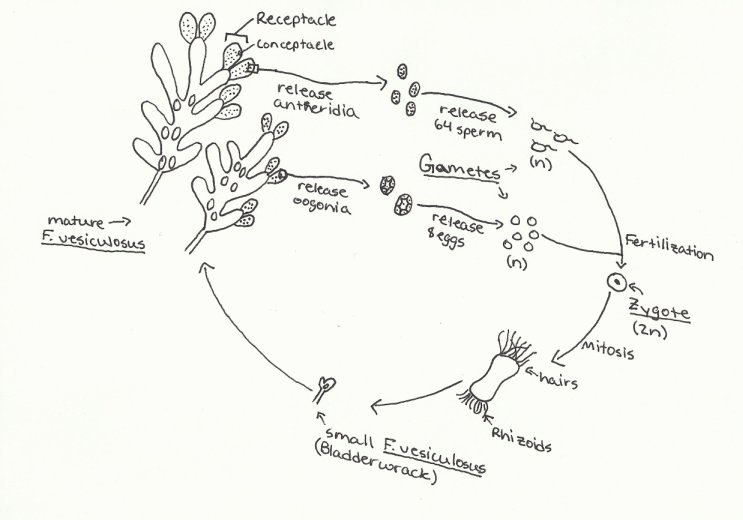
The birds and the bees of algae
The British Broadcasting Alga
Bladderwrack is a dioecious organism, meaning that male and female
gametes are produced on two different organisms. The organism
requires water for reproduction, as it produces flagellated sperm
that move toward the egg to fertilize it via the water, this is
called
broadcast spawning. You can learn more about
flagella of another alga (a green algae) by visiting the site on
Chlamydomonas reinhardtii.
Even algae love the summer
Fucus vesiculosus only produces its gametes during two seasons out of
the year, those seasons being spring and summer. The rest of the
year the offspring grow and mature, and the mature bladderwracks
just enter a vegetative state. The thing that is odd about this is
that a species that is very closely related to bladderwrack,
Fucus serratus, reproduces at the exact opposite time, possibly
helping to prevent
polyspermy. This is discussed later on in this section.
 Not
very good odds for the guys...
Not
very good odds for the guys...
Sperm and eggs are produced in structures called conceptacles
that are small structures on a receptacle. You can see both of these
structures in the picture to the left. The overall structure is a
receptacle, and the little bumps are the conceptacles. The
receptacles are swellings at the end of the thallus when the
organism is about to reproduce. The structures that reside in the
conceptacles that produce the female gametes are called oogonia and
contain eight eggs each. The male reproductive structures are called
antheridia, which also reside
in the conceptacles. The antheridia carry 64 sperm cells each before
they release the cells into the
water.
Bladderwrack
is obviously the smart cousin
In
addition to only releasing its eggs and sperm during summer and
spring, F. vesiculosus also has a developed a timing
mechanism for release of its gametes during the day. Relative to its
very close cousin F. serratus, F. vesiculosus
releases a lot more eggs later in the day and at lower tide than its
cousin. Researchers speculate that bladderwrack has developed this
because it is preventing rapid dilution of its gametes that require
sperm to fertilize them. This fertilization process would become a
lot less probable if the eggs were spread out and diluted, as would
happen at higher tides.
 Females
and their "perfume"
Females
and their "perfume"
You may wonder how the sperm find the egg to fertilize it. The
process is obviously not passive, like spores of certain trees,
since the sperm are flagellated. It's actually a lot like how humans
attract one another: pheromones. The female egg actually releases a
species non-specific pheromone that attracts sperm in its direction.
Because the pheromone is species non-specific, the egg may attract a
male gamete that it is not compatible with. The way the sperm ends
up knowing whether it can fertilize the egg are the oligosaccharides
on the cell wall of the egg. The photo to the left is of a sperm and
egg pronuclei (the dark spots)
just before fusion and the creation of a zygote. The cell is stained
with hemotoxylin which stains the chromatin of the nucleus.
Living in the "rough neighborhood"
Fucus vesiculosus seems to thrive in areas where other marine species
fail to reproduce. The reason why so many marine species are unable
to live in these areas that Bladderwrack can survive in is because
of the low salinity. Low salinity has multiple effects on the male
gametes, which bladderwrack has seem to overcome. Low salinity can
decrease the motility and length of life of gametes of most
organisms, and also increase the rate of polyspermy. Polyspermy is
lethal to almost all species, but bladderwrack has a few mechanisms
to overcome this. The first is a fast block. The fast block is a
change in membrane potential of an egg, and happens in a few
milliseconds of sperm-egg fusion. This reduces the chance of another
sperm fusing with the cell membrane of the egg. Another polyspermy
block is a slow-block, which happens over the course of a couple
hours, and is basically the growth of a cell wall around the
organism. The image to the right was taken by Ester Serrao. The
blue/whitish eggs are stained with calcifuor white, which turns the
cell wall white. As stated earlier, the cell wall is formed after
fertilization, so the blue/whitish eggs are fertilized, and the dark
eggs are unfertilized.
overcome this. The first is a fast block. The fast block is a
change in membrane potential of an egg, and happens in a few
milliseconds of sperm-egg fusion. This reduces the chance of another
sperm fusing with the cell membrane of the egg. Another polyspermy
block is a slow-block, which happens over the course of a couple
hours, and is basically the growth of a cell wall around the
organism. The image to the right was taken by Ester Serrao. The
blue/whitish eggs are stained with calcifuor white, which turns the
cell wall white. As stated earlier, the cell wall is formed after
fertilization, so the blue/whitish eggs are fertilized, and the dark
eggs are unfertilized.
The Circle of Life for F.
vesiculosus
The picture below shows the entire life cycle of Fucus
vesiculosus. The conceptacles first release either antheridia
or oogonia depending on the sex of the plant. The antheridia then
release 64 sperm cells and the oogonia release eight eggs each. The sperm
cell
then fuses with an egg and fertilizes it to create a zygote. The
zygote then goes through mitosis to eventually turn into a small
bladderwrack and then the organism eventually grows into sexual
maturity with the signature pairs of bladders, and the cycle then
repeats itself every year.
